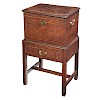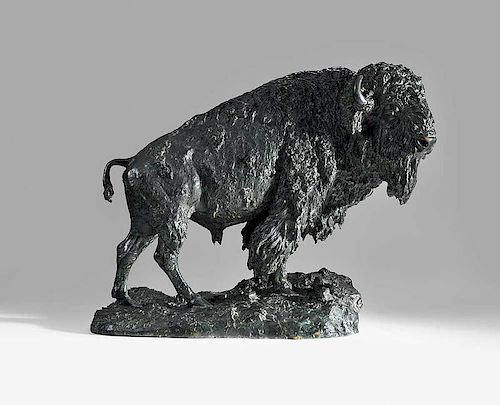(New York, 1871-1922)Buffalo-Monarch of the Plains, signed "H.M. Shrady/1901" and inscribed "Copyright 1901/Theodore B. Starr" and stamped "13" on outcropping near proper left rear hoof, early 20th century casting, patinated bronze (112.5 lbs), 23 x 23 x 11-1/2 in.; Note: Admired by great sculptors, Karl Bitter and Frederic Remington, Henry Shrady became an important master of the American Renaissance at the turn of the 19th century. This rare and important bronze has a long history of ownership from one of the brilliant and kinder industrial "robber barons", John William Mackay. It was willed to his trusted employee and friend, Edward Armstrong. A good argument could be made that it was acquired from the artist himself through association with the Goulds, relationships which centered around some of the great sporting properties, specifically at Jamestown in the Piedmont region of North Carolina.Henry Shrady studied law before an illness prevented him from continuing. It left him with time to discover his true calling as an artist during his long recovery. His wife submitted his first recorded painting titled Fox Terrier Seizing a Mouse to the National Academy in a move that both sold the piece and gained the attention of influential figures in New York art circles. Among those figures was a 5th Avenue entrepreneur and jeweler, Theodore B. Starr, who commissioned and copyrighted bronzes to sell out of his shop. Shrady's sketches, including his own horse and various animals made on his many trips to the Bronx Zoo attracted Starr's attention. From these studies, sculptures were created including an elk buffalo, called Monarch of the Plains, executed in 1899 and Bull Moose in 1900. According to the National Gallery of Art's biography on the artist, "these were some of the very first American bronzes to be cast by the lost wax method, pioneered in the United States by Riccardo Bertelli at his new firm of Roman Bronze Works in Brooklyn in the late 1880s."Karl Bitter encouraged him to pursue sculpture and gave him space at his studio in New York. Remington saw his Elk Buffalo and purchased it. He stated in his diary September 29, 1908 "'Buffalo'... best art object I have." The attention he gained gave him a commission to create monumental scale models of these two bronzes in plaster for the Pan-American Exposition in 1901.It was Roman Bronze Works that would quickly be Shrady's foundry as his popularity grew. In response to an inquiry concerning this bronze from Edward Armstrong, President and founder of Roman Bronze Works, Inc., Riccardo Bertelli states in a letter dated November 4, 1940 on company letterhead, "With reference to the Bronze Buffalo mentioned in your letter, I am glad to tell you that I am familiar with this work as Mr. H.M. Shrady was a personal friend of mine and a very prominent sculptor who died much too young. The bronze in your possession is very rare as I think we only cast in bronze five or six copies of it". Similarly, The Metropolitan Museum mentions their bronze, Bull Moose, is stamped with the number "5" but does not have a Roman Bronze Works foundry stamp. Bertelli also viewed this bronze in 1939 and suggested how many were cast by his foundry.The bronze was acquired by John William Mackay who started life in Ireland in extreme poverty. After moving to America and his father's death, he worked small jobs until he made a decision to work and invest in mining ventures in Nevada. He would eventually come to co-own the largest vein of silver and gold ever discovered in North America and controlled the richest vein of the Comstock Lode in Virginia City, Nevada. Through wise investments and partnerships he eventually grew to be enormously wealthy. He created the Postal Telegraph Company which directly competed with Jay Gould's Western Union Cable Company. With his vast wealth he purchased a an extensive property and lodge in Jamestown, Guilford County, North Carolina which he called the Deep River Hunting Preserve. Interestingly, George Jay Gould, the son of Jay Gould also held a large hunting preserve near Mackay. In an article "Hunting Lodges have Rich Histories", Mary Browning states,"The Gould and Mackay hunting establishments were connected by more than proximity. The professional dog handlers and estate managers employed by them were a father and son, John and Edward Armstrong, who were essential to the operations — John Armstrong for Gould and Edward for Mackay." George's brother, Edwin Gould, Sr. (1866-1933) married Henry Shrady's step-sister, Sarah Cantine Shrady (1875-1951). Shrady served from 1895 to 1900 as an officer of the Continental Match Company, a company established in 1894 by Edwin Gould. He would often visit the Gould family's hunting preserves in the Berkshires and North Carolina. We believe this bronze likely came through those close connections. The lot is accompanied by the original letter on Roman Bronze Works letterhead authenticating the bronze and signed by Riccardo Bertelli; a partial facsimile copy of an appraisal for the bronze dated July 15, 1993 which mentions a consultation with "sculpture experts from Christie's (New York)" who stated the value saying it would likely bring "as much as $80,000-100,000" at auction; a partial facsimile of an early inventory from the hunting lodge listing the bronze and a value of $15.It is also accompanied by the EDS metallurgical analysis performed by SEMTEC Laboratories, Inc.Copper 96.11, Tin 3.31, Lead 0.41, Iron 0.16Literature: Broder, Patricia Janis. Bronzes of the American West. New York: Harry N. Abrams, 1974, pg 241, ill. 242.The Amateur Sportsman, Volumes 40-41, Outdoor World Publishing Company, 1908, pg 12.References: Metropolitan Museum of Art (New York, N.Y.), Thayer Tolles, Lauretta Dimmick, and Donna J. Hassler. American Sculpture in the Metropolitan Museum of Art. New York: The Museum, 1999.https://www.greensboro.com/news/hunting-lodges-have-rich-histories/article_2140543e-c591-5fc9-ae3a-bd36c0f99eb4.htmlhttps://www.nga.gov/collection/artist-info.2272.html; Provenance: John William Mackay (1831-1902), New York/Deep River Hunting Preserve, Jamestown, North Carolina; Willed to Proprietor of the Hunting Preserve and Lodge, Edward Armstrong, Ireland/Jamestown, North Carolina; By descent in family
Condition
verdigris to black/black patination with some rubbing on areas including base, tail and nose
































